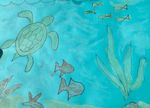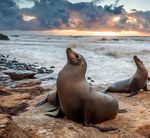Diversity in Ecosystems: Day 1 - Tennessee Aquarium
←
→
Page content transcription
If your browser does not render page correctly, please read the page content below
Diversity in Ecosystems: Day 1
This week, Weekday Wonders will help young scientists explore the variety of living things in our world.
To do this, they will consider where animals live in different habitats, including oceans, rivers, streams,
and forests. Young scientists will also have a chance to consider what lives in their own backyards and to
learn the difference between a habitat and an ecosystem.
These curated activities are listed in a suggested sequence but may be done in the order that works best
for you and your young scientists. Learn more about this series in the Introduction to Weekday Wonders.
Question of the Day
Where do animals live in the ocean?
Daily Nature Journal
Ask your young scientists to spend some time outside completing their daily nature journal.
Use the Guide to Nature Journaling support them in nature journaling each day. They will
develop a new appreciation and wonder for the world around them.
Animals of the Ocean
Have your young scientists think about the animals they know that live in the ocean. Ask
them to draw the animals in the ocean and label them. Encourage them to draw the animals
where your scientists think they live—in shallow water, deeper water, or very deep water.
Extend the lesson by having your scientists explore The Deep Sea interactive at https://neal.fun/deep-
sea/. Your young scientists can explore the animals that live in the ocean as well as how deep they live.
Have them pay attention to how much light there is in different parts of the ocean. Some animals that live
in the ocean need sunlight and have to live near the surface (Euphotic Zone). Other animals live in the
Twilight Zone (Disphotic Zone), the open ocean where only a small amount of light reaches. Other
animals in the ocean live in the Midnight Zone (Aphotic Zone), where no light reaches at all. These
animals must get their energy from some other source besides sunlight. Ask your young scientists to add
animals that interest them to their drawing along with how deep the animals live in the water.
WEEKDAY WONDERS | ©2020 TENNESSEE AQUARIUM 1Ocean Densities
The ocean is a vast ecosystem that is home to hundreds of different species of animals. These
animals have adapted over thousands of years to be able to survive in different levels of the
ocean. As young scientists may have discovered in the “Animals of the Ocean” activity, some animals live
near the surface of the ocean while others can only live in the deepest parts. This investigation will help
your young scientists learn more about the different depths of the ocean.
Start by gathering the following materials.
1 glass or mason jar
Vegetable or Olive oil
Dish soap
Honey
Water
Food coloring
Funnel, food baster, or syringe (optional)
A variety of small objects
Have your young scientist begin by pouring the honey into the glass. He or she should pour the honey
carefully into the center of the glass without allowing it to run down the sides of the glass. Add honey
until the layer is 1 to 2 inches thick. Let the honey settle before adding the next layer.
Next, have your scientist add a layer of dish soap 1 to 2 inches thick. Have them pour slowly and evenly
into the center, trying not to let the soap touch the sides of the glass.
Prior to adding the next layer, have your young scientist add a few drops of food coloring to water. Then
add a 1 to 2-inch layer of water to the jar. This layer will form more easily if the water runs slowly down
the side of the glass. A funnel, food baster, or syringe may help the water run down the side.
Have your young scientist add the last layer by carefully pouring the oil into the glass, once again making
sure you let the oil run down the side of the glass just as you did with the water. You may want to use a
funnel, food baster, or syringe for this step.
Allow your scientist to gently add small objects to the glass. Have them observe how many layers each
object can pass through and which layer holds them up. Try objects like paper clips, small pieces of paper,
grapes, screws, bottle caps, a raisin, a coin, or a small rock. You may wish to have your scientist make a
data table to show the findings.
This experiment works because each liquid we add to the glass has a different density, similar to how
each layer of the ocean has a different density. In the ocean, all the layers are made of water, but as the
water gets colder deeper in the ocean, it is denser. The water particles do not move as much, meaning
more of them are packed into the same space than when the water particles are warmer. In this
investigation, you used different liquids to make the layers clear.
Discuss with your scientist about how they think the deeper, denser layers might affect the animals that
live in the ocean. Have them consider that there are colder temperatures and less light where the ocean is
deeper. The density is also one of the main reasons for ocean currents.
WEEKDAY WONDERS | ©2020 TENNESSEE AQUARIUM 2Salt Water Painting
Gather the materials your young scientists will need for this activity.
Paper (dark construction paper works best)
Paint brush
¼ cup salt
¼ cup of very warm water
Food coloring
Measuring cups or small containers
If your scientists have been to the ocean, ask them about
the water and what it was like. They should realize that it
is made up of salt water. Let them know that there is a
limited amount of water on Earth and that rain, lakes, and
rivers do not have much salt. Ask about their ideas for how
that happens.
Then, have your scientists measure equal amounts of
warm water and salt into a cup and stir until no more salt
will dissolve. Have them add about 3 drops of food
coloring to the mixture. Repeat for any other colors they
would like to use.
Ask them to paint an ocean habitat and the animals that
live there. If they would like to draw their design first, have them use a pencil so that the water does not
cause ink to bleed. Let the paintings dry overnight.
The water will evaporate from the painting, and the salt will stay on the paper. Ask your scientists about
what part of the “paint” evaporated and which part remained. Then ask if they can make a connection to
why rain is not salty. They may need some help, but they should realize that ocean water evaporates,
leaving salt behind, to make many of our weather events that happen on Earth.
WEEKDAY WONDERS | ©2020 TENNESSEE AQUARIUM 3Ocean Yoga
Animals in the ocean not only live in many different habitats but they also move in many
different ways. Have your young scientist use the Ocean Yoga poses that start on page 4 to move like
some of the animals that live in the ocean.
Ocean Yoga Poses
Pufferfish: Pufferfish often live in and around the coral reefs of the ocean and use their ability to blow up
to a large size as a way to protect themselves from predators. Many types of pufferfish are also
venomous! Can you take some deep breaths and puff up like a pufferfish?
Crab: Some crabs spend time near the shoreline of the ocean. Others live their whole lives on the ocean
floor. Crabs are invertebrates, meaning their skeleton is on the outside of their body. It is known as an
exoskeleton. They also have ten legs, which help them move quickly from one hiding place to another.
Some crabs also have two pinchers to help them catch food and defend themselves. See if you can crawl
like a crab!
WEEKDAY WONDERS | ©2020 TENNESSEE AQUARIUM 4Sea Lion: Sea lions are a large and athletic type of seal that spend a lot of time playing and chasing fish in
the ocean. When they are ready for a break, they like to spend lots of time laying out in the sun on the
beach. Can you sit and stretch like a sea lion!
Whale: Whales are some of the largest animals in the world! They live in the ocean water but have to
come up to the surface so they can breathe. Some whales look for small food like tiny shrimp-like animals
called krill near the surface of the water. Other whales dive deep into the ocean to find squid. Stretch like
a whale coming up for a breath of air!
WEEKDAY WONDERS | ©2020 TENNESSEE AQUARIUM 5Octopus: The octopus is one of the smartest animals in the world! They can be found anywhere from tide
pools to coral reefs and even all the way down to the bottom of the ocean. Octopus can change their
colors and appearance in a flash to hide from predators or to sneak up on a meal. With eight strong,
suction cup covered arms, they can easily “jet” away from danger. Can you move your arms like an
octopus?
Lobster: Lobsters are often found in crevices and small hiding spaces in rocks, coral reefs, and the ocean
floor. They move from place to place by walking along the ocean floor or swimming backwards quickly if
confronted by a predator. Try to sit like a lobster and reach out with your pinchers!
WEEKDAY WONDERS | ©2020 TENNESSEE AQUARIUM 6Jellyfish: Jellyfish can be found almost anywhere in the ocean. They can live in cold waters of the arctic,
warm waters in the tropics, or in the deepest part of the ocean. They can range in size from a half inch
wide to six feet wide. Their tentacles can be used for protection as well as for catching food. Think of
them as arms. Some tentacles can be up to fifty feet long! See if you can stretch like a jellyfish!
Sea Star: Sea stars live in many different parts of the oceans, including tide pools, coral reefs, kelp forests,
and the ocean floor. Most sea stars have five arms covered with hundreds of tiny tube feet that have
serious suction power. This helps them move around easily in any of these habitats. They use a small
mouth on the bottom of their body to help keep the ocean clean. Relax and stretch like a sea star!
WEEKDAY WONDERS | ©2020 TENNESSEE AQUARIUM 7You can also read



























































